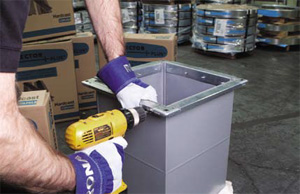Having a leak-free system is possible and the four-bolt flange connection system provides these benefits after a quality installation, assuring the comfort level and indoor air quality of any facility, John Guthrie explains.
Lower cost, decreased pollution, and energy efficiency are all achieved by airtight ductwork. Having a leak-free system is possible and the four-bolt flange connection system provides these benefits after a quality installation, assuring the comfort level and indoor air quality of any facility, John Guthrie explains.
It is estimated that in the US, nearly 90% of new and existing air systems, in all commercial applications, suffer from varying degrees of leakage. It is also estimated that the average efficiency of these HVAC systems is less than 60%. If the equipment is not served well by its air distribution system, the unit is prevented from reaching the factory-specified efficiency rating that it’s designed to achieve. Some duct closure systems will leak after installation, requiring extra sealant to achieve air tightness.
 The four-bolt flange connection system stands out by attaining an airtight seal without requiring additional sealing. This system uses raw duct and applies a heavy-duty flange closure frame, which creates an airtight seal and an easy install for contractors. It consists of four components:
The four-bolt flange connection system stands out by attaining an airtight seal without requiring additional sealing. This system uses raw duct and applies a heavy-duty flange closure frame, which creates an airtight seal and an easy install for contractors. It consists of four components:
Another advantage is the total weight of the sheet metal required for the ductwork. Other closure systems require the use of a heavier gauge sheet metal, increasing the material and labour cost of the installed finished product. The difficulty with installation of some closure systems makes it troublesome to achieve the airtight seal required. The four-bolt flange connection system allows easy replication of the closure system with some basic training, thus eliminating wasted labour and leaky duct joints. Laboratory tests have shown that a joint made according to the manufacturer’s instructions has no leaks up to a service pressure of ten inches of water gauge.
Using the best closure system achieves overall better quality at lower costs. Without leaks, the unit will require less time to cool or heat a facility, which will use less energy and increase the life of the equipment. With less energy required to obtain the same comfort level, the overall environmental impact of the comfort system is improved. The secondary benefits of lowering pollution, increasing building comfort, and lowering peak demand on the electrical grid make having an airtight seal in the HVAC ductwork a high priority. Properly sealed ducts also keep dust and other airborne particles, which can aggravate asthma and allergies, from building up in the air distribution system.
By choosing the best duct closure system, facility managers and owners can achieve lower installation and operating costs while increasing the effectiveness of the comfort system of their facility.
The writer is Regional Sales Manager, Carlisle HVAC. He can be contacted at john.guthrie@ carlislehvac.com
Copyright © 2006-2025 - CPI Industry. All rights reserved.